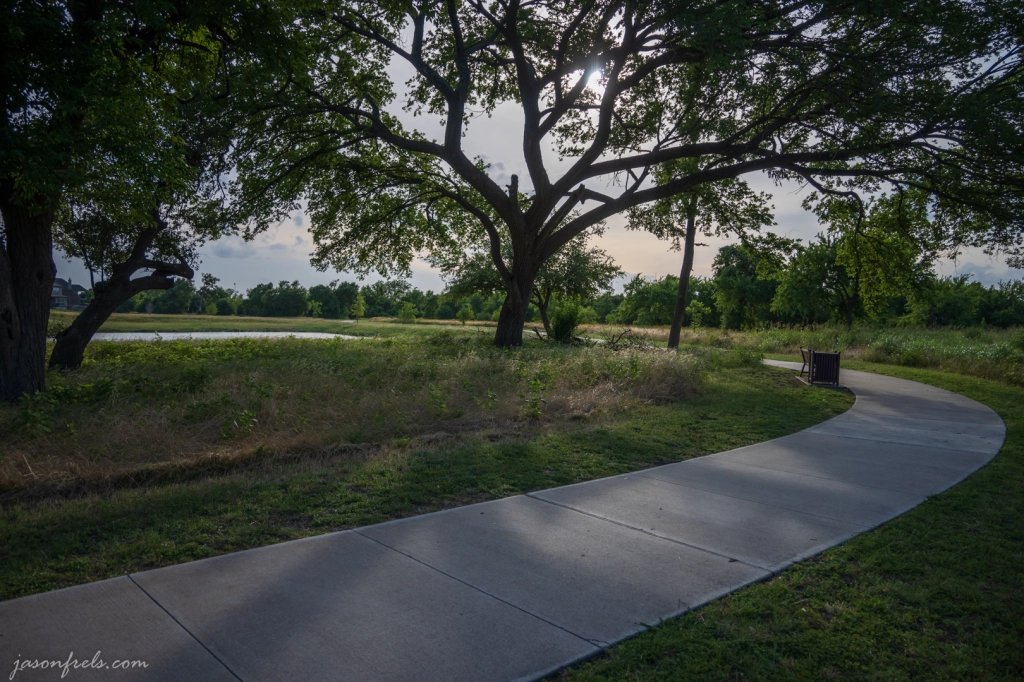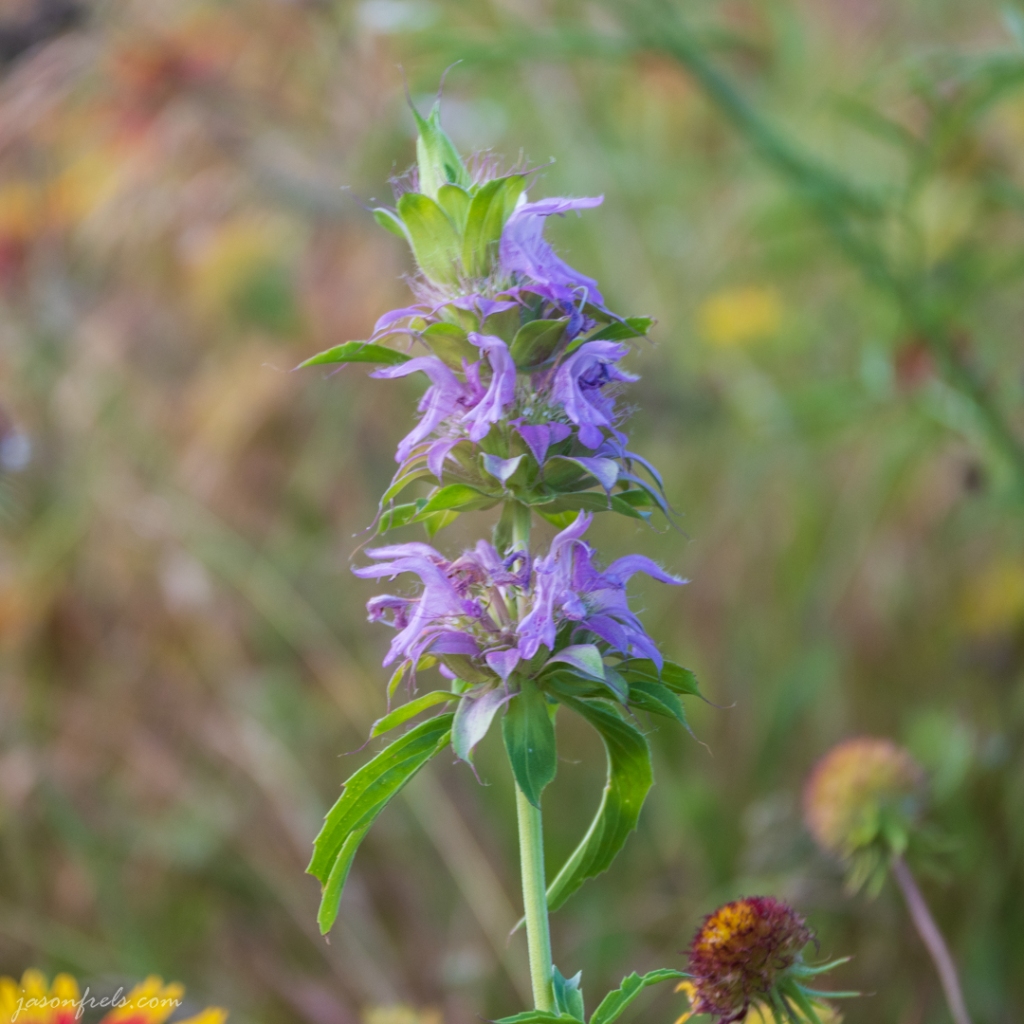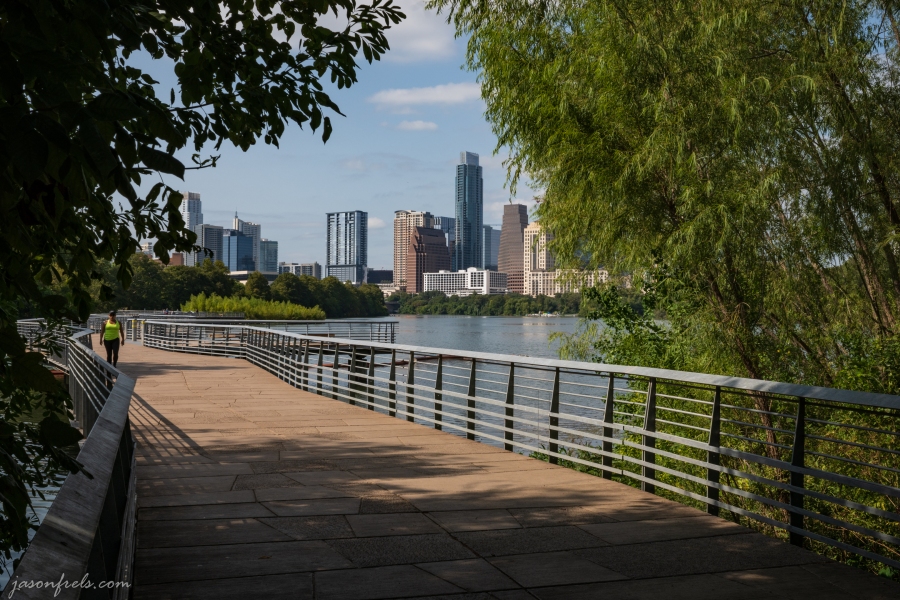I enjoy hiking as well as photography. I usually carry my camera along on my hikes as I like to take photos of landscapes or other details that I see. But, my DSLR can get quite heavy after hiking for a while. So, I have had my eye on a smaller and lighter, but still quite capable camera for hiking. I still want the more capable DSLR for serious photography expeditions.
The camera that I settled upon in the Nikon Z50. This is a relatively new camera from Nikon and it is amazingly small and light-weight compared to its capabilities. It fits into a small pouch or even a pocket and will be nice for casual hikes. The image below shows the D750 full-frame DSLR on the left and the Z50 on the right. You can see that the D750 and 24-120mm kit lens dwarfs the Z50 and 16-50mm kit lens. Note that the D750 has a tripod bracket on it that makes it a little bit bulkier.

To aid with the compactness, the lenses for the Z50 retract when not in use. In the side-by-side image below you can see that when the lens is in its closed position it is much more compact than when it is in the 16-50mm range.

The Z50 is a mirrorless camera with a 20MP crop sensor. Mirrorless meaning that the view finder doesn’t look through the lens via a mirror that flips out of the way when you take a picture, but rather has a tiny electronic screen in the viewfinder. Crop sensor meaning that the sensor is a bit smaller than a full-frame sensor (see the comparison below). These two features can make the camera both smaller and lighter as there is not the bulk of area needed for a moving mirror and the camera has a physically smaller sensor. This also means that the lenses can be smaller.
The kit that I bought came with the camera and two lenses.
- Nikon Z50 20.9MP DX-format digital camera
- NIKKOR Z DX 16-50mm f/3.5-6.3 VR standard zoom lens
- NIKKOR Z DX 50-250mm f/4.5-6.3 VR telephoto zoom lens
- A memory card
The NIKKOR Z DX 16-50mm f/3.5-6.3 VR zoom and the NIKKOR Z DX 50-250mm f/4.5-6.3 VR telephoto zoom are compact and designed to work with the crop sensor camera, or DX sensor in Nikon’s terminology. With the sensor being smaller, the effective focal length of the lens is approximately 1.5 times the equivalent on the full-frame cameras. So, the 16-50mm shoots like a 24-75mm focal length on the D750 and the 50-250mm shoots like a 75-375mm on the D750. This is not good for extreme wide-angle shots, but it does provide a lot longer zoom than I have for my D750 at the moment.

As a bonus, I was able to get an ‘open box’ kit at the camera store, meaning that I got 10% off the price for a new camera. I love these kinds of deals. The camera is 99.9% new and had maybe a dozen images taken with it before I got it.
Lenses and Sample Pics
I had originally wanted to get this before I went on a spring hiking trip to Big Bend National Park, but that was all cancelled. So, I have taken it on my walks around the parks near my house to get a feel for its capabilities. Below is a photo taken at 16mm, the widest possible with the 16-50mm lens and equivalent to shooting at 24mm on a full-frame camera.
As you can see, the sun is bright in the sky beyond the trees and this would be a challenging single-exposure for any camera. I had to reduce the exposure compensation by 1ev for this shot. The sun is over-exposed and clipped of course, but the rest of the sky has detail along with the shaded area under the trees. There is a little noise in the darkest shadows, but you have to really go looking for it. So, pretty good dynamic range. This was shot at 16mm, F/3.5, 1/1600s, ISO1000.
Below is a photo taken at 50mm very close to some flowers. I used a tripod so I could use ISO100. This lens has a published minimum focus distance of 0.3m at 50mm and I wanted to see what some close-ups would look like.
The image was shot at 50mm, f/6.3, 1/25s, ISO100. This was taken in a shaded area and there is the slightest amount of noise in the darker areas if you go looking for it. I think that I would have gotten slightly better contrast and detail if I had used the D750, but this is a good quality photo.
Moving on to the NIKKOR Z DX 50-250mm f/4.5-6.3 VR telephoto zoom. This lens does provide a lot of reach, but is not very useful for wide shots like you often take of landscapes. But it is nice for capturing details. Below are some wildflowers at the park. The first image is shot at 145mm, f/5.3, 1/200s, ISO140. The colors in the blurred background are almost swirling, which is nice. It was hard to hold still and wait for the breeze to die down.
Next is a close-up at the full 250mm. This was shot at 250mm, f/6.3, 1/200s, ISO250. I used pin-point focus and it was quite difficult to hold it on target with even a light breeze. But I was patient and got a keeper or two.
Both of these lenses have vibration reduction built-in, which is very helpful at the longer focal lengths.
Below is a full image of a bird that I shot. I believe it is a Western Kingbird which is suppose to be common around these parts. I shot it at 250mm, f/6.3/ 1/1000s, ISO100.
Next is a crop of the image that I made. You can see there is plenty of resolution for cropping and posting online.
Both of these lenses are a bit limited in terms of max wide aperture, going down to f/6.3 at the longest focal length. This might be a problem in a low-light situation resulting in you having to push the ISO pretty high to compensate. But, that is the price of compactness. You can look at the low aperture zoom lenses for any camera and see that they are giant, heavy, and very expensive. So, a bargain in terms of price and weight and for my shooting, I just get a tripod if I have low light so no real problem. But these lenses are not ideal for sports and wildlife.
My Thoughts
The main reason that I got the camera was for the ease of hiking or walking around with it. The camera meets this need quite nicely. Even after walking around for an hour I don’t even notice the strap on my shoulder whereas the D750 would feel like it was cutting into me. The Z50 with its two lens is about 935g total compared to the D750 with 24-120mm f/4 lens at 1460g. So, less weight for gear and a smaller bag and more range.
Using the electronic viewfinder takes some getting used to. When you are using a DSLR and the camera is at rest and then you bring the camera to your eye you are looking through the lens immediately and you are ready to shoot with no break in the flow of activity. In contrast, with the electronic viewfinder, the screen is off when the camera is at rest to avoid running down the battery so when you bring the camera to your eye you have to wait a second for the screen to come on. This delay breaks your photographic work-flow and can be a bit frustrating. If I can remember to half-press the shutter button while bringing the camera up, it minimizes this issue.
Another difference is that when you are using a DSLR and you take a photo, the mirror comes up for the duration of the shutter and then comes back down and you see again. This feels like just blinking your eye and it not distracting. Unless you are taking a long exposure, in which case you are probably using a tripod and the screen on the back anyway. In contrast, when using the electronic viewfinder in a mirrorless camera, you are looking at the sensor readout so when you press the shutter button this is halted, the shutter closes then opens to take the picture, the sensor is then read and the image stored, and then the shutter re-opens and the electronic viewfinder comes back on. This black-out is much more pronounced in a mirrorless camera and takes some getting used to. This is a bit irritating when taking photos of a moving subject like an animal, but you can get used to it.
You can review photos in the viewfinder with the mirrorless camera which is nice on a sunny day when it is difficult to see the screen on the back of the camera. I have often had this problem trying to review images on the back of my D750 and can barely see the screen because of the bright sunlight, so this is a welcome feature, though my nose keeps hitting the zoom button on the touch screen.
The grip on this camera feels familiar and fits your right hand quite well. Nikon is known for having good ergonomics with their cameras and this one is no different. My only issue has been my nose hitting a button on the screen, I think, I may be doing something else incorrectly. I do like the dedicated ISO button as I had reprogrammed the red movie button to that on my D750. There are also two programmable function buttons on the front of the camera near the grip that you can easily reach with your right hand fingers. I personally program these to adjust auto-focus settings with one button and control bracketing with the other, but you can set them up how ever you like.
The lenses on this camera are Nikon (Z mount) but they won’t work on my other Nikon camera (F mount) because the mount is different for mirrorless cameras to make the camera more compact. There is an adapter I could get to use my F-mount lenses on the Z-mount mirrorless camera but I am not sure I need that at the moment. Besides, putting the heavy full-frame glass on this camera would kind of defeat the point.
Nikon does make full-frame mirrorless cameras with the Z mount, so if I ever want to get one of those cameras, the lenses will be interchangeable with the Z50. There is a Z6 that is similar in capabilities to the D750 that I already have, but it is not really that compelling of an upgrade for me at this time as both cameras will be able to take pictures at the same quality. There is a much more expensive Z7 that has a much higher resolutions sensor, but it is a bit more than I am willing to spend right now. My 24MP photos are not holding me back at the moment.
Thanks for reading. At his point, I would recommend this as a nice, good quality walking around camera that is very capable. I have been going through the Reference Manuals and find this to be a very feature rich camera if you want to use more advance techniques. If you would like to know something about this camera that I didn’t mention, let me know. I will probably post more about it as I use it and gain experience with the new features.












It’s too bad your trip to Big Bend got cancelled, but this park looks wonderful. You can really see the difference a good camera makes, looking at the quality when using a zoom lens, or when shooting close-ups. I have a fairly good camera, but it’s too clunky to carry around on a walk, so have to rely on my good old phone camera. Your photos are lovely!
LikeLiked by 1 person
Thanks. I appreciate the nice comments.
LikeLiked by 1 person
I like the firewheel photo especially but all the photos look good.
LikeLiked by 1 person
That firewheel shot is Awesome!
Glad you were able to find a lighter weight but still excellent camera to take hiking.
LikeLiked by 1 person
Thanks
LikeLike
You are welcome! And you know if you find yourself bored I think you would be a great teacher for a photography class. 🙂
LikeLiked by 1 person
Don’t think I have that level of expertise. But thanks for saying so.
LikeLiked by 1 person
🙂
LikeLike
I love the squirrel picture 🙂
LikeLiked by 1 person
Thanks
LikeLiked by 1 person
Hi from Spain. I have sold my Nikons D810 and D750 and I’m really happy with my new friend, the Z50. Yes, perhaps it has less possibilities, but does it really matter? Now I can walk on the mountains without feeling I’ve got a cow on my back. I only wish Nikon presents us a pancake, let’s say a 24/3.5 and then I’d be totally happy.
LikeLiked by 1 person
Hi, I recently bought a cheap little Meike 25mm, f1.8 lens for the Z50 that I have been experimenting with. It is manual focus and aperture and there are no chip features, but you can focus using focus peaking with some practice. It is very small and light weight and from what I can tell a very sharp lens. I have had it for a couple of weeks now and am getting the hang of using it.
This photo was taken with the Meike lens:

LikeLike
Nice review! I rented the Z50 for a 4-day backpack and was really impressed (Some photos here: https://www.cbakerphotography.com/blog/timberline-trail-august-2020). My go-to camera is also a D750. I really don’t want to own (2) cameras, but the D750 seems heavier each time I take it with me on a hike. I’ve tried the Sony A6400 and the Fuji XT-20, but they didn’t leave me wanting more. The Z50 did. Today I killed about 3 hours on the web debating on buying it, and I still haven’t dropped the hammer. My other thought…getting a prime lens or 2 for the D750 and calling it good, but the Z50 would allow for more flexibility with their zooms. Decisions, decisions. =) Thanks again for your detailed post.
LikeLiked by 1 person
They also make a Z5 now that is not much more expensive than the Z50. It is full frame and probably slightly larger. I am not sure as I have not held one. There is a nice review here: https://photographylife.com/reviews/nikon-z5
I love the Z50 because it is very light and compact and I don’t mind carrying it anywhere. The guy at the camera store tried to tell me that it would take better photos than the D750, but I can tell you that the D750 takes better photos for me. But I have better lenses for the D750.
I also got my Z50 open-box which saves some money. Maybe you can find one like that.
LikeLike
Thanks, Jason! The Z5 has been on my radar as well, but the higher-end Z mount lenses are pretty expensive. Hopefully, that will change in time. I’ll probably stick with my D750 and pick up a Z50. It was such a fun camera.
Have a great week!
LikeLiked by 1 person
Thanks. Yes those S-line lenses are expensive
LikeLike